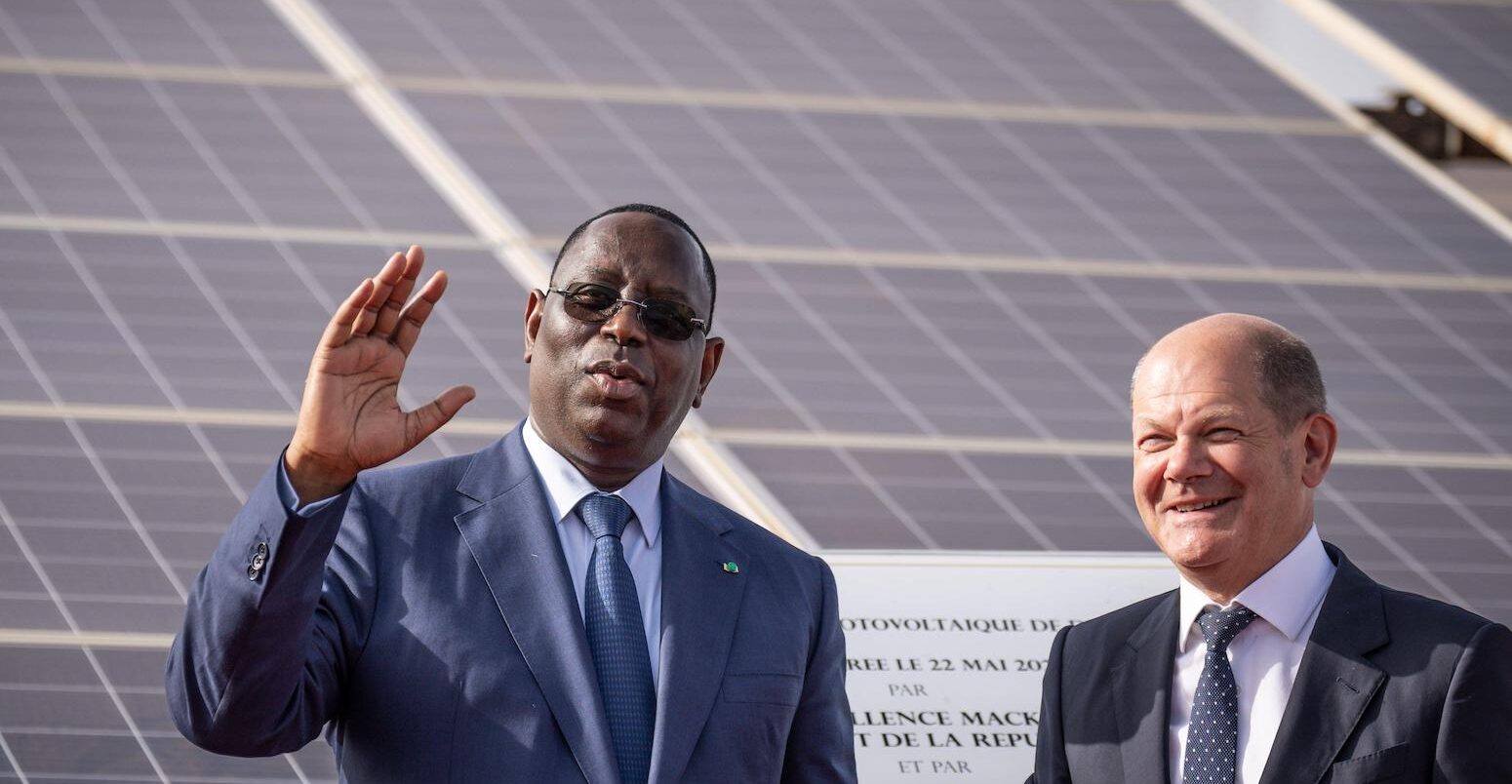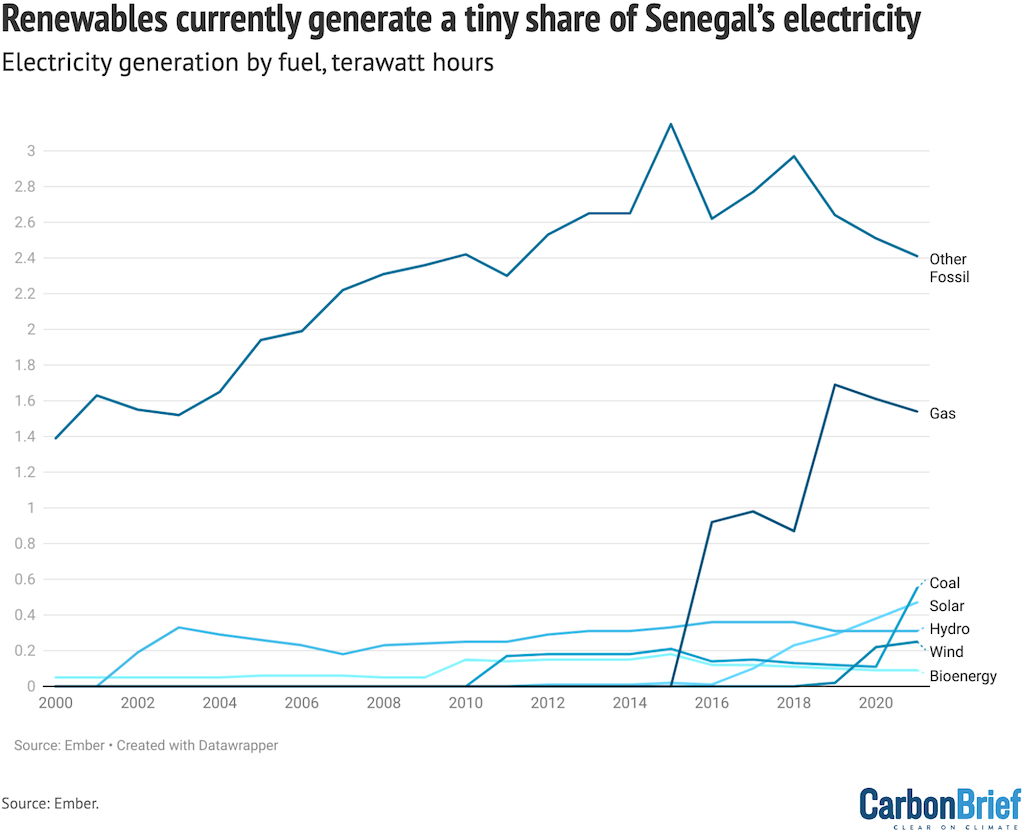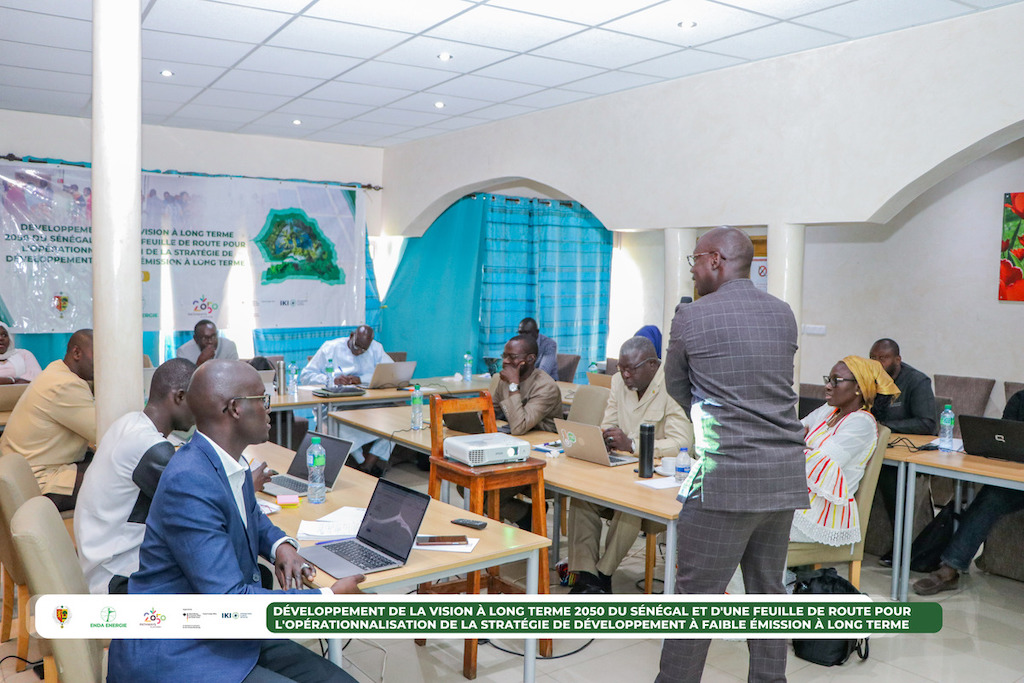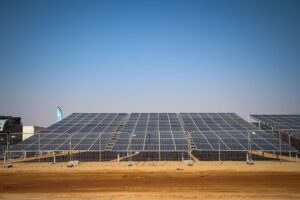
Guest post: Behind the scenes at Senegal’s ‘just energy transition partnership’
Multiple Authors
09.06.23In June, Senegal signed a “just energy transition partnership” (JETP) deal, establishing a goal to reach 40% renewable energy in the electricity mix by 2030.
But, beyond just a transformation of the electricity sector, this deal sets out a pathway to transform the whole of Senegalese society.
The JETP is a joint political declaration between Senegal’s government, France, Germany, Canada and the EU. They will provide €2.5bn in funding to support the new goal, the majority of which will be provided through preferential loans, while €150m will be provided through grants.
It will offer significant opportunities for investment in the country and marks “a milestone along the road to a Senegalese economy that is both climate neutral and socially just”, according to German chancellor Olaf Scholz.
The political process that led to this agreement was actively supported by our work under the initiative to co-construct a low-emission and climate-resilient development strategy (LECRDS).
This was led by the Senegalese civil-society organisation ENDA Energie with the support of thinktank IDDRI, as coordinator of the international Deep Decarbonisation Pathways (DDP) initiative, and in collaboration with the Ministry of Petroleum and Energy (MPE) and the Ministry of Environment, Sustainable Development and Ecological Transition (MEDDTE).
Long-term transformation
The 2030 renewable energy target is just one milestone in a much larger, long-term agenda for the transformation of the energy system in Senegal. But we found that the level of ambition of the 2030 target has strong implications for the type of transformation that will be possible by 2050.
This means it is only possible to evaluate whether the 2030 target is ambitious in the context of a wider vision for transformation until 2050, which will be kick-started by the JETP.
The initiative led by ENDA in Senegal explored different types of energy transitions, with different levels of ambition by 2050.
As a first step, these scenarios looked at where current national policies take the country by 2050 in terms of, for instance, energy access for the population, total energy demand and production and the share of renewable energy in the electricity mix.
Then we developed more ambitious scenarios to explore faster paces of renewable energy production increases, the electrification of transport, industry and the housing sector. Additionally we considered a more moderate increase in energy demand than in the “current policy” scenarios, which extend current trends into the future and assume no policy changes from today.
The analysis shows the difference between an ambitious and a more conservative target for the percentage of renewable energy in the electricity mix in 2030.
We found that a 30% renewables target would correspond to existing governmental plans, which assume a significant development of gas alongside renewable energy sources.
In contrast, our analysis showed that a target to achieve 40% renewables by 2030 was consistent with reaching 75% in 2050 – which we consider an ambitious target for Senegal.

Development
The Senegal JETP focuses most immediately on the energy transition, but has very important implications for broader national development issues in the country – particularly given its position as a least developed country and the need for universal energy access.
As of 2019, 30% of the households did not have access to electricity, according to the Senegalese national statistical agency. A condition for the JETP was, therefore, that the renewable target would not undermine this – or any other national development objectives.
Analytical work done as part of our initiative to co-construct pathways in Senegal supported the possibility of achieving both climate and development goals simultaneously. When looking in detail at how energy services can be provided in different sectors, we found that there is no indication that a 40% renewable energy target would hamper the achievement of universal electricity access.
However, this requires significant investments in renewable energy production, in connecting households to the electricity grid and in supporting the electrification of the industry- and transport sectors.
The in-depth analysis of whether renewable energy targets in the JETP would infringe upon key development goals required a detailed knowledge of domestic data sources and energy-related issues.
For example, there was an important question related to how imported hydropower is counted in the national energy accounts, which could be clarified only thanks to ENDA’s detailed knowledge of Senegalese energy-data, informed and updated by the MPE.
Domestic ownership
Like other country projects undertaken in the DDP initiative since 2013, the initiative in Senegal offers a national insider perspective on the low-carbon transition and its interplay with domestic development priorities to build domestic ownership.
In the case of Senegal, this was done by bringing together a wide array of national stakeholders over the past 18 months to collectively build and analyse long-term climate and development visions for the country on the basis of robust analytical work.
Our experience in Senegal, as in other countries, is that agreeing to an international engagement on an aspect of the economy as critical as energy is only possible with a real sense of ownership by key domestic stakeholders.
This mirrors the DDPs underlying principle: energy transitions, and the underlying questions of development and finance, must be grounded in national realities to make them truly just, implementable and sustainable.
The underlying work conducted under the initiative, starting with securing an explicit mandate from the Senegalese MPE and MEDDTE, was instrumental in creating this sense of ownership, and by extension, for securing the deal.
The initiative conducted its analysis through a technical and in-depth dialogue involving around 50 local stakeholders representing government, academia, civil society and the private sector.
This consultation process, which started long before the JETP negotiations were initiated, lasted for around one-and-a-half years. The nationally led and inclusive process ensured that the conclusions were based on the best available information, reflected a diversity of perspectives and could be endorsed by a wide range of national actors.
Furthermore, the initiative in Senegal provided a space for structured exchanges among actors that were key in the definition and implementation of the policies required to achieve the 2030-target. This gave those involved confidence about the capacity and buy-in needed to implement the deal.

What happens now?
The JETP deal is only the beginning of a process, which will need to be followed by implementation. This includes the drafting of an investment plan for the €2.5bn in preferential loans and grants, as well as concrete policies for energy production, consumption and access that will achieve the 2030-target.
Although marginal in most concluded JETP-deals to-date, a very important component of JETP’s is the link with the long-term low emission development strategies (LT-LEDS) that all countries are encouraged to develop under the Paris Agreement. These are a planning tool to facilitate the alignment of global climate and national development objectives.
Currently, 64 countries have drafted LT-LEDS – of which only six are African – and Senegal is currently in the starting blocks of its LT-LEDS development.
LT-LEDS in general are not limited to the transformation of the energy sector, but looks broadly at how the entire national economy will achieve climate and development objectives.
Anchoring the energy transition in a broader, more systemic vision of the transition in which the country will need to embark, as encouraged by LT-LEDS, brings actors from all sectors on-board. Furthermore, it helps bring transversal questions that do not fit in any sector, such as unemployment and poverty, into the scope of the vision.
Discussions on international support for the transitions of other sectors beyond energy should be based on sectoral transition plans in the LT-LEDS, in order to ensure that the international support feeds the national sectoral development vision.
The initiative provided the basic elements of the JETP deal and is also in charge of conducting the analytical work feeding the LT-LEDS.
This guarantees coherence and interconnection between the policies and actions required to reach the JETP target, and the broader transformation of the country.
The Senegalese JETP shows that a nationally led and domestically inclusive process to elaborate a long-term climate and development vision is a crucial step in defining shorter-term targets.
Furthermore, it shows that such a long-term vision can be leveraged, with success in international discussions, to ensure financial support for national energy transitions.
-
Guest post: Behind the scenes at Senegal’s ‘just energy transition partnership’





